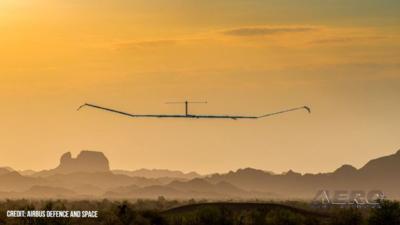Solar-Electric UAV Lost
Airbus’s Zephyr Unmanned Air Vehicle (UAV) speaks, more or less, to what the albatross might be had Elon Musk had a hand in its design—a graceful, conditionally lovely, high-flying critter borne aloft for months on end by vast wings and solar-powered batteries.

The latest model—the Zephyr 8—has a wingspan of 82-feet (25-meters), weighs a scant 165-pounds (75-kilograms), and spent the summer of 2022—most of it, anyway—soaring over the American Southwest.
Regrettably, the Zephyr 8’s summertime sojourn came to an unexpected and tragic end on 19 August, when, for reasons passing understanding, it fell from the Arizona sky just hours short of breaking the 64-day, 22-hour, 19-minute, 05-second continuous flight record set in 1959 by two lunatics in a Cessna 172 Skyhawk.
By way of explanation, Airbus representatives stated only: "Following 64 days of stratospheric flight and the completion of numerous mission objectives, Zephyr experienced circumstances that ended its current flight. No personal injury occurred. Our teams are currently analyzing more than 1500 hours of stratospheric mission data. The valuable experience from this prototype’s ultra-long endurance flight has proved to be a positive step toward the Army’s high-altitude platform goals."

Flight-data from the dearly-departed Zephyr 8’s ADS-B exchange shows the aircraft—callsign ZULU82—completing a serpentine maneuver, then entering a rapid, near-vertical descent of 4,544-feet-per-minute before impacting the desert floor.
The Zephyr—as thou engineers, pilots, and aerodynamicists have likely concluded—is a solar-electric powered machine that spends its flying days charging its 53-pound lithium-ion battery-array, and its flying nights depleting them. The twin-propeller, unmanned vehicle is marketed by Airbus as a High-Altitude Platform Station (HAPS) with military, commercial, and institutional use cases and customers. Zephyr has been approved by the aviation authorities of five countries, none of which are particularly concerned about an accident occurring after 64-days of continuous, un-refueled, un-serviced, autonomous flight.
Thou engineers, pilots, and aerodynamicists still wondering how the record-breaking Cessna 172 remained perpetually aloft for over two-months are apt to appreciate the ingenuity that saw the Skyhawk’s fuel capacity increased to 142-gallons by means of a 95-gallon belly-tank and an electric pump system that moved fuel to the aircraft’s wing tanks. Through-firewall plumbing was then installed that engine oil and oil filters could be changed while the engine was running. When fueling was required—as it was 128 times throughout the record-setting flight—a fuel truck would rendezvous with the flying Cessna along a stretch of straight road. An aircraft-mounted electric winch would lower a hook, by which a fuel hose was lifted to the Skyhawk. The non-flying pilot then stood on a platform attached to the right-wing strut and filled the belly tank. Fini.
 ANN's Daily Aero-Linx (05.02.24)
ANN's Daily Aero-Linx (05.02.24) ANN's Daily Aero-Term (05.02.24): Touchdown Zone Lighting
ANN's Daily Aero-Term (05.02.24): Touchdown Zone Lighting Aero-News: Quote of the Day (05.02.24)
Aero-News: Quote of the Day (05.02.24) ANN FAQ: Contributing To Aero-TV
ANN FAQ: Contributing To Aero-TV NTSB Final Report: Cirrus Design Corp SR20
NTSB Final Report: Cirrus Design Corp SR20




